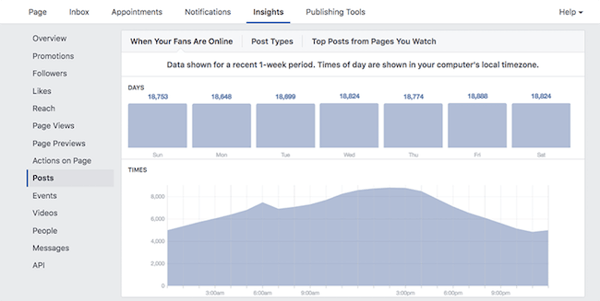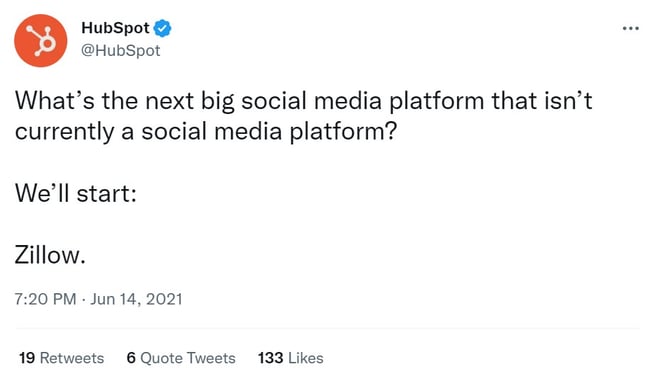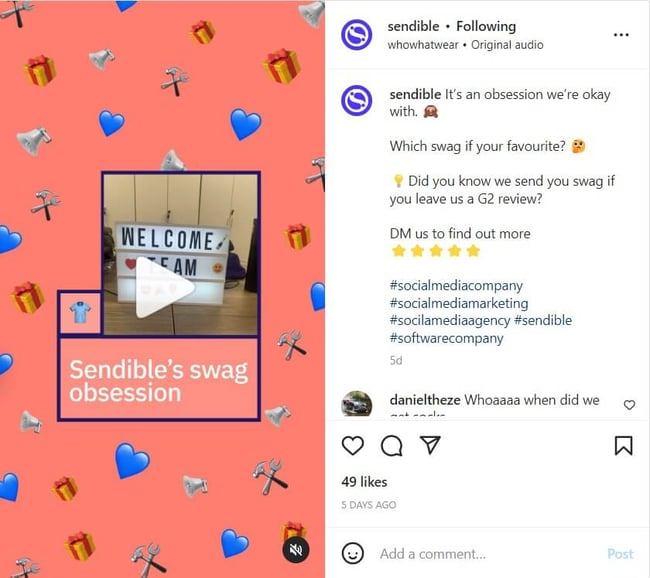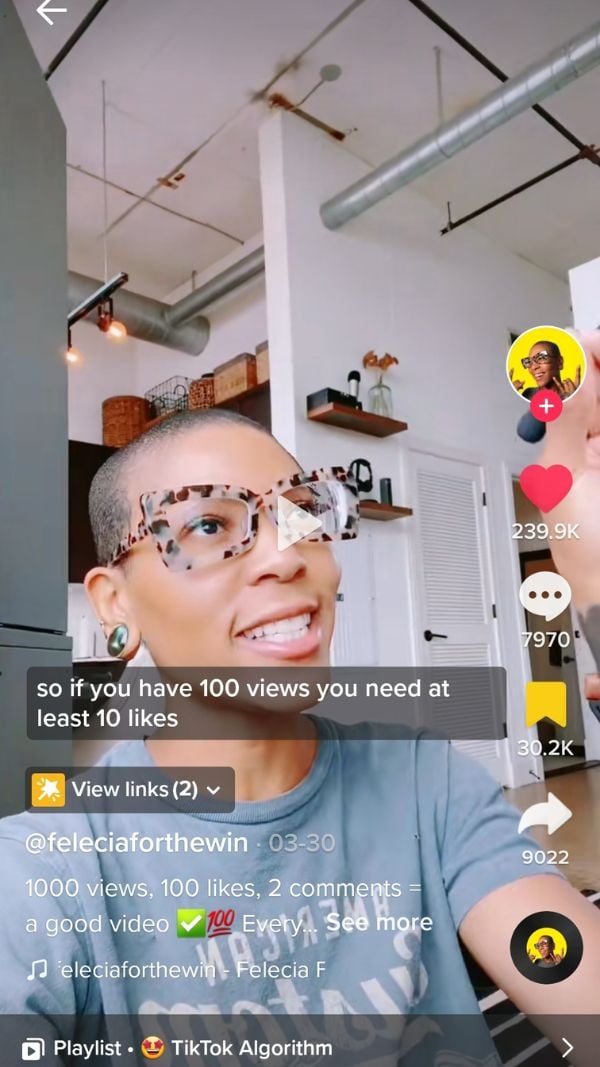It's one of life's great mysteries.
After debating whether TikTok is a viable marketing platform, you'll want to know how often you should post on social media.
As a social media manager, you want to achieve the best result from each social media post. There has to be a good time and a bad time to post, right?
In this guide, we'll answer this proverbial question so that your content can reach a wider audience.
- How often should you post on social media
- Best practices for posting content on social media
- How to plan your social media content for 2024

How to Create a Social Media Content Calendar for Your Agency Clients
How often should you post on social media
Over the years, I've read countless articles regarding the optimal posting frequency on social media networks. And I've concluded that they're all flawed.
One article suggests posting no more than twice a day on Facebook. The next one says you should post to LinkedIn on weekdays only, preferably between 4 pm and 6 pm. And others warn you not to tweet more than three to five times a day.
But, in reality, there is no magic formula for deciding how often to post on social media.
That's because what works for one brand doesn't work for another. Sure, you can read case studies of what has worked for others but don't make their solution your solution.
So, instead of seeking magic formulas, let's focus on these proven posting strategies:
Aim for consistency, not frequency
The problem with suggested posting frequencies is the skewed data. It's okay to say, "We analysed thousands of posts and this is what we found..." but this is still a 'mish-mash' of data.
For instance, how does the location of you and your audience affect posting, and how do different industries react to the number of posts shared?
One of the most baffling suggestions is that you should post at a specific time of day. For example:
- "For best results on Facebook, post once a day between 1 pm and 4 pm."
This is such an ambiguous statement.
For a start, does it mean 1 pm Sydney, 1 pm London or 1 pm New York? Or does it mean the equivalent of 1 pm CST in your local time, so, for example, 1 pm CST would be 7 pm GMT. That's quite relevant, isn’t it?
Imagine everyone heeding this advice and posting it at 1 pm EST (New York). For 23 hours, Facebook would remain dormant before exploding with thousands of posts at the allotted time.
A better alternative is to aim for consistency when posting on social media. Create a content plan and stick to it.
For example, if you decide that your social media post frequency should be twice a day on Facebook, you know you need to create or curate content to fill that schedule. Your audience will know that they can visit your page at any given time and expect two fresh posts every 24 hours.
The chances of your content being pushed to someone's newsfeed have been reduced following changes to social media algorithms. You need people to start coming to you. And the best way to attract them is to have something worthwhile for them to digest.
The best social media publishing frequency is: when it's worthwhile. - Jay Baer, Convince and Convert
This brings us to the next point.
Content quality trumps quantity
There's only one thing worse than not posting on social media, and that's posting something that's not relevant. There really is no point in posting something to fill a slot in your schedule at 1 pm CST or whatever time you've been advised.
You're more likely to lose fans and followers if you post poor-quality content. This rings especially true in times of crisis, such as recession, where you must focus on making your content as useful and heedful of the situation as possible - whether by providing facts or the much-needed distraction.
So if you want to create relevant social media content, you must focus on helpfulness and authenticity principles. If you want to make sure your content hits the mark with your target audience, it's time to give your social media channels a thorough check-up. And guess what? We've got free templates to help you do just that!
- Instagram Audit Checklist
- Facebook Audit Checklist
- X (Twitter) Audit Checklist
- LinkedIn Audit Checklist
To put it simply, you want your posts to make sense to the person engaging with them.
If you've ever seen a post on social media from a well-known brand that leaves you scratching your head and thinking, "What's the point of that?" or "How does that relate to their brand?" you'll know what I mean.
It's what UnMarmarketing founder Scott Stratten calls Brand Pulse:
If you post something irrelevant, pointless, or worse in social media, the pulse slows. If you post something interesting and useful, the pulse quickens.

Scott Stratten’s Brand Pulse concept was referenced by Jay Baer as a good mindset when determining your social media posting frequency. It makes sense - the more relevant and timely your content is, the more value and engagement you can generate.
It's no surprise that the ever-changing algorithms on social media want to promote the best content. At the end of the day, consumers want quality content.
Set goals and objectives
Consistently posting high-quality content is the right way to go when considering how often to post on social media. Still, you also need to evaluate your overall social media strategy. And if you're an agency, you'll surely want to confirm your plan with your clients before publishing content on their behalf.
Simply put, if you don't know your social media goals, you won't know if your posts are successful.
Until you determine what your goals and objectives are, there is no way to measure success. - Melonie Dodaro, author of LinkedIn Unlocked.
So step back a minute and ask yourself: "What do I want to achieve on social media for my brand or my client?" Could it be you want to:
- Increase brand awareness?
- Drive traffic to your website?
- Sell a product or service?
For instance, if your objective is to drive traffic to your website, but instead, you get thousands of likes and no clicks on your post, then it was unsuccessful.
Similarly, if you've helped your client sell more products, it's not necessarily negative when you get fewer shares.
Best practices for posting content on social media
With these three concepts in mind, let's examine how you can maximise your social media posts.
First, there are a couple of general suggestions:
Followed by social media platform-specific tips:
- How often should you post on Facebook
- How often should you post on X (Twitter)
- How often should you post on Instagram
- How often should you post on LinkedIn
- How often should you post on TikTok
1. Tailor your content to suit each network
It's no good copying and pasting your LinkedIn post to Instagram. That won't work. Instead, consider which types of content are best suited to each social media network and go from there. For example, do videos get higher engagement on Facebook than images? Change up the copy, hashtags and emoji's for each post too. Yes, tailoring will take a little longer, but remember you want to post quality content.
Sendible's Smart Posts feature lets you tailor your post to different networks so you can edit the text, add or remove hashtags, mentions, and emojis as required.
2. Engage with your audience
Posting content is one-half of a conversation. Social media is all about being both proactive and reactive, so you'll need to be available to join in the discussion when people respond to your posts. The quicker you can respond to posts and comments, the more reactive and human your brand will seem, and the more your community will grow.
So ensure your community manager is up for this challenging task.
How often should you post on Facebook
We all know that the Facebook News Feed algorithm aims to reduce noise for its users and encourage real interactions between them.
So, what's the best way to optimise your social media strategy?
Get to know your audience with Facebook Page Insights to see who is viewing and interacting with your content.

If you're using a social media management tool like Sendible, then make use of the additional analytics.
Produce quality content that's suited to Facebook and that you're comfortable creating. There's no point in making poor-quality videos if you're more skilled at writing or graphic design. Alternatively, try broadcasting Facebook Live Videos if you think that suits your brand.
Whether you’re using Sendible or posting natively to Facebook, what matters most is that you’re posting quality updates.
Experiment with your content schedule until you find what works best for you and your audience. Ultimately, trial and error is the best way to find out how often to post on Facebook.
How often should you post on X (Twitter)
Following the example of Facebook and Instagram, X (Twitter) introduced changes to its policy in 2018.
Give everyone the power to create and share ideas and information instantly, without barriers. - X (Twitter)'s Mission Statement
But, even though its statement remained the same, we've witnessed the emergence of more than one obstacle to getting your brand's tweet out there. Such as prohibiting duplicate content and limiting the ability of third-party tools to schedule content that's too similar.
It only makes sense that, similar to other social media networks, X (Twitter) made alterations to its algorithm to ensure that the right content reaches the right people.
Users can now adjust their timeline to first display the top tweets or the latest tweets from the accounts they follow.
So, if you want to ensure your client's or brand's tweet ends up at the very top, you need to pay attention to the ranking signals for the X (Twitter) timeline algorithm. These include:
- How recent the tweet is
- Use of rich media (images, GIF, video)
- Engagement (likes, replies, retweets)
- Prominence of author
- Relationship of the user to author
- User behaviour
Now you're probably wondering how to optimise your posting strategy. Well, we found that focusing on keeping things fresh is far more critical than chasing that "ideal posting frequency":
- Create posts with images, GIFs or videos.
- Ask questions to prompt conversations.
- Share quotes to inspire.
- Use hashtags and mentions for broader reach.
- Curate content from other sources in your industry.
Here's an example from Hubspot:
 Source: @HubSpot
Source: @HubSpot
Finding the best time to tweet depends entirely on your target audience. We suggest posting content at different times to see what works best for you and your clients. You can still use scheduling tools to post around the clock when you might be sleeping but your audience is awake. Just remember to follow up on conversations when you're back and remain authentic.
Track your analytics on X (Twitter) to see what's working – and what's not – with your tweets and your audience. Take advantage of additional social media reporting tools to dig deeper.
How often should you post on Instagram
Instagram has also made changes, primarily by deprecating its old API and introducing a new API that allows the direct publishing of photos to Business Profiles.
Instagram is a visual platform, so what's the best way to use it for your brand?
Post high-quality photos and videos that showcase your product or service in the best possible way. Nobody wants to see grainy photos or watch videos with poor sound quality. You have to project a professional image for your brand.
Take your audience behind the scenes. Give them a taste of what it's like to work at your company. Or what happens in the canteen. Bring your brand photos to life with real-life experiences. Remember that authenticity is everything.
 Source: @sendible
Source: @sendible
Try using Instagram Stories to post fresh content daily, as it disappears after 24 hours. Other than allowing you to test different creative approaches, it provides you with the opportunity to engage your audience and learn more about it through quizzes, polls, and questions.
As a bonus - Instagram allows you to insert a direct link on stories to an external piece of content! So, if your client or brand is not an eCommerce business, and you have no use from Instagram Shop, you can now link your stories directly to the articles or pages you wish to promote.
Instagram Stories allow you to post more, without tarnishing your brand’s image.
The stories appear at the top of the newsfeed, so you can catch your audience's attention as soon as they open the mobile App. And if your content is top-notch, you'll have people craving your daily update.
Remember to add hashtags and mentions in your message. Instagram captions can be a tough nut to crack, but remember that the more compelling your captions are, the more engagement your posts are likely to receive.
Experiment with Instagram Reels. They're Instagram's answer to TikTok videos and are proving to be a great source of engagement on the platform. In fact, short-form videos are one of the top social media trends this year! So make sure to use this format to maximise your ROI.
Analyse your performance. You'll only find out what works for you and your clients through testing and measuring results. If you have an Instagram Business Profile, then you could do this on the app with Instagram Insights. Equally, if you'd like to take a deeper dive into your client's Instagram performance, you could conduct an Instagram audit to get a clearer picture of how their content is doing.
How often should you post on LinkedIn
LinkedIn is becoming a more hands-on social network that rewards consistent posting and engagement. And, more importantly, it's becoming much more personal due to the decrease in digital trust.
LinkedIn expert John Espirian shares some examples of how he increased engagement on LinkedIn. You may want to try these ideas and see if they work for you:
- Write text-only posts to get more engagement. You'd think images or videos would be better, but John found text-only worked best for him. So make sure to include this content format into your social media calendar and track results to see if it improves your engagement rate.
- Use relevant emojis and icons in your posts to break up text and make your post stand out in the news feed.
- Use LinkedIn native video rather than sharing a link to a video on YouTube or Vimeo. LinkedIn likes to keep content self-contained on its platform rather than linking to outside resources. But, if you really want to include a link to an external content piece, paste it in the comment under the post.
- LinkedIn loves comments. Like Facebook, if your post gets good comments, then LinkedIn will start sharing it with an extended audience, so you'll get more views, engagement, and shares. It's self-perpetuating.
- Utilise hashtags on LinkedIn to reach a wider audience with your content. With hashtags gaining more traction than ever, learning how to use hashtags on LinkedIn is a worthwhile route to achieving higher engagement on your posts.
- Try LinkedIn Polls to increase organic engagement. This a great way to gauge the pulse of your followers by asking them relevant questions related to their or your industry.
- Experiment with carousels on LinkedIn. Research has shown that Instagram carousels are the most engaging post type. And now you can finally use them on LinkedIn as well! Remember that the uploading process is slightly different- you must import it as a PDF document. So, once you've created a carousel for Instagram, simply export it as a PDF file and watch your engagement rate increase on LinkedIn.
How often should you post on TikTok
TikTok's mission is to inspire creativity and bring joy.
"The system recommends content by ranking videos based on a combination of factors - starting from interests you express as a new user and adjusting for things you indicate you're not interested in, too."
The For You feed is one of the defining features of TikTok, and the true magic of this social media platform is that there are no two identical feeds. And another thing that separates TikTok from other social media platforms is that the primary feed a user sees is the For You Page (known as #fyp) which includes videos from both creators you follow and those you don't.
This means that the TikTok algorithm is a complex and refined recommendation system and that multiple factors influence what shows on your feed.
There are many myths when it comes to posting on TikTok, such as the ratio and milestones theory that suggests that every 10th, 50th, and 100th video gets pushed to a greater audience. So, according to this theory, the more you post, the quicker you'll reach those "milestones".
 Source: @feliciaforthewin
Source: @feliciaforthewin
But I would advise you to take it with a pinch of salt. While posting more frequently is advised, publishing quality content is a must. Focus on how you can help your audience, not how often you can spam them with irrelevant information.
So if you're serious about stepping up your TikTok marketing, you might want to pay attention to the factors that most definitely have an impact on the algorithm:
How to plan your social media content for 2024
Now that you know content quality trumps posting frequency, you might wonder how to plan your content calendar for the upcoming year.
After the turbulence of 2020 and the fact we're facing a recession, it might be tempting for social media managers to avoid planning too far in advance and rather take each month as it comes.
If that's your strategy, then you could consider relying on holiday-themed social media content to populate your social media calendar.
It makes perfect sense, really - certain social media holidays happen year after year, consistently, so you can rely on people to celebrate them, no matter what.
So, if you're unsure of the sort of content to schedule for 2024, why not consider clinging to seasonality in order to drive traffic?
Some solid holidays to celebrate on social include:
- #ValentinesDay💘 - celebrated on the 14th of February every year
- #IndependenceDay 🎊 - celebrated on the 4th of July every year in the US
- #Halloween 🎃 - celebrated on the 31st of October every year
- #ThanksgivingDay 🦃 - celebrate on the fourth Thursday every year in the US
- #BlackFriday 🛍 - celebrated every year on the day after Thanksgiving Thursday in the US
- #ChristmasDay🎄- celebrated on the 25th of December every year
If you're looking for more social media holidays to celebrate, then check out our social media holiday calendar. It's packed with 300 events and actionable tips to help you celebrate them with your followers.
Final thoughts
To summarise: There is no magic frequency when deciding how often to post on social media, and you don't have to post at a particular time. The key is to post relevant, quality content on a consistent basis and keep an eye on the times your audience engages with your content the most often.
Knowing what to post on social media and how often to do it are both key to running a successful agency. If you'd like to know more, check out our useful guide on how to start a social media marketing agency. In this free resource, we walk you through gaining authority as a new agency owner as well as the most productive ways of managing your client's social media profiles.
And now, it's over to you.











